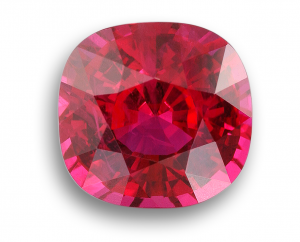 Few gemstones have the visual impact of a ruby, the rich red color catching the eye from the instant that it is seen; it is the color which defines a ruby. Any stone either slightly too dark, or bordering on pale and pink is regarded in the jewelry trade as a pink or purple sapphire, even though there is more latitude on color outside the USA.
Few gemstones have the visual impact of a ruby, the rich red color catching the eye from the instant that it is seen; it is the color which defines a ruby. Any stone either slightly too dark, or bordering on pale and pink is regarded in the jewelry trade as a pink or purple sapphire, even though there is more latitude on color outside the USA.
This precious gemstone gets its name from its color, the Latin for red being ruber. Chromium is the impurity that provides the richness of color and the value of a ruby is largely determined initially by that color. Ruby is particularly hard on the Mohs scale, behind only diamonds and moissanite amongst natural gems. It is an aluminate with those chromium impurities. All natural rubies have these impurities with the rutile imperfections creating a needle effect. Interestingly, it wasn’t until the 19th century that the Rubies were determined to be the corundum mineral (similar to Sapphires). Before this, even red Spinels and Garnets were incorrectly classified as Rubies due to their color.
What Color are Ruby Gemstones?
As with most colored gemstones, the value of a ruby is primarily based on the purity of color. In the case of rubies, it is the red hue with secondary hues varying from purple and orange through to violet and pink, purple perhaps being the hue that best reinforces the strength of the red. Such a ruby set in gold as it appears even richer in color because of the yellow gold neutralizing any blue.
Poorly colored Ruby gemstones are common. Although the description of pigeon blood red is hardly an attractive term, it is a designation that has become the norm in describing the most valuable colors of a ruby. A deep, pure vivid red is the most prized color – these are also sometimes known as ‘Burmese’ rubies because of their original sources from Myanmar . Whilst dark pink and brown content are acceptable as colors of rubies, the value of such stones drops dramatically in relation to the pigeon blood red (all these “reds”‘ should not be confused with garnets)
Do Ruby gemstones have inclusions?
In practice, natural Ruby gemstones without any inclusions are extremely rare. As such, Clarity will usually play a limited part in the valuation of a ruby. Note however, that not all inclusions are visible to the naked eye. So, an ‘eye-clean’ ruby, with minimal inclusions can command a high price. In fact, the presence of inclusions often helps distinguish a natural Ruby from a synthetic gemstone. Sometimes inclusions bring about a rare ‘cat’s eye’ or ‘six-ray star’ optical effect in the stone – star rubies are often prized additions to rings. It is almost impossible to find a ruby that needs no treatment; the color is created by impurities. Only the best rubies are faceted and these are the ones with minimal inclusions. The common inclusions are in the form of white wisps of rutile, the white obviously diminishing the richness of the red.
What is the best Cut for Rubies?
An important factor considered by traditional gem cutters is to select a cut that does not to lose too many carats – as the best of rubies are so rare and valuable. As a result, cuts selected are often imperfect. This is because the gems cutter may try to avoid diminishing the overall value by preserving size versus going for the perfect cut.
To find perfection in the cut, it may sometimes mean a loss of up to 60% of its weight, a very costly exercise. That said, the best cut displays a ruby in all its glory, with light reflecting from every facet. It is much more common however to see a cut with uneven facets and less sparkle. An indicator of a poor cut is if you can see through the ruby and is relatively less valuable as a consequence.
How does carat wight impact the value of a Ruby?
The cost per carat of a ruby varies significantly based on its size. It increases dramatically with the larger stones given that they are so rare. Very small rubies are common; however, there is a premium in the price, in addition to carat weight, whereby the rarity of the stone is factored in. For example, the price per carat can increase by much as tenfold for stones larger than 3 carats.
It is taken as a given that most rubies are treated; they almost always have inclusions and the heat treatment improves color and clarity, and in the poor quality stones, fissures on the surface of the stone are filled with glass or synthetic crystal to enable use of the ruby in jewelry. It is important that the treatment to improve the ruby is permanent; anything less will certainly reduce the ruby’s value. Anything that is too clear will immediately arouse suspicion that it is synthetic; perfect clarity and rubies do not often go together.
Famous Rubies
Whenever a “perfect ruby” was found historically, given they are so rare, there are only a few places where it can ultimately end up, a museum, royal jewelry collections or the home of the extremely rich. Arguably the most famous is the Black Prince’s Ruby – part of the Imperial State Crown of the UK. Another famous ruby, the Rosser Reeves star ruby resides in Washington DC at the Smithsonian ; a 128 carat star ruby – this is considered to be the largest star Ruby in the work. If faceted Ruby Jewelry is what you like gushing over, the Carmen Lucia Ruby, also at the Smithsonian is a 23 carat ruby set with diamonds in a platinum ring, a gift from Peter Buck, a wealthy businessman in memory of his late wife. The stone is believed to have been found in Burma in the 1930s.
Burma was the main source of rubies for most of history but their distribution is now widespread throughout many parts of Asia, countries such as Tanzania and Mozambique in Africa and large deposits have now been found in Greenland.
Physical Properties of Ruby
Formula : Al2O3:CR
Symmetry : Trigonal
Crystal : Hexagonal prisms.
Specific gravity : 4
Mohs scale hardness : 9
DO RUBY Gemstones Scratch easily?
The short answer is no! From the Mohs scale of mineral Hardness – Rubies are almost at the top – the only thing that could scratch a Ruby is a Diamond!
Ruby Myths and Legends
Trade in rubies began centuries ago; there are references to the Trade in the days of the Silk Road and it could have been as early as 200BC when the trade first began. They remained gemstones that were highly prized throughout Asia through the Centuries ad that value has subsequently been recognized throughout the World. Legend has it that Ruby’s protect its wearer from poor health and misfortune. In ancient Burma, Warriors believed that Rubies gave them an aura of invincibility on the battlefield.
Whatever the reason, be it mystical healing properties or its gorgeous red color, a ruby is a valued addition to any gemstone jewelry collection – and makes for a great gift.
